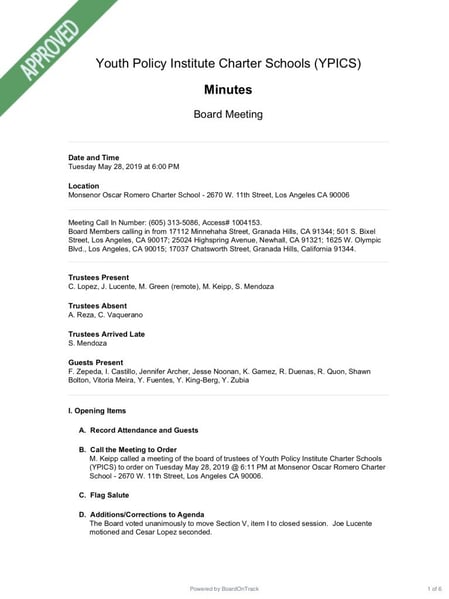
What Should Your Charter School’s Board Meeting Minutes Look Like?
Minutes are a record of what was done at your board meeting. They’re legal documents that auditors and other verifiers may review. And, as an important part of transparency compliance, the public may review them as well.
Your charter school’s board meeting minutes must be accurate and clear, and must never reflect the opinion of the minute taker.
Here’s how to manage meeting minutes that improve your board’s efficacy and easily comply with relevant regulations.
See How BoardOnTrack Can Help You:
Your charter school board meeting minutes should include:
- The time the meeting was convened
- The name of the presiding officer
- The full names of present and absent members
- The full names of any guests who are in attendance
- The main points of discussion
- Any motions made
- Whether any of the attendees arrive or leave during the meeting
- The time of adjournment
Structure Your Minutes to be Brief and Easy to Read
Minutes must be recorded in accordance with the order of what happened during the meeting.
Use a separate paragraph for each subject. This allows for anyone reading the minutes to see the flow of the meeting as it happened.
At the top of the minutes, list the name of the organization as well as the date, time and location. 
In the first paragraph, specify the time that the meeting was convened and the name of the presiding officer.
In addition, list the full names of those present and absent — as well as any guests in attendance.
If any of the attendees arrive or leave during the meeting, minutes should include the time and name within the flow of the minutes.
Note the approval (and amendment) of the minutes of the previous meeting. Note the review and acceptance of the financial report.
And, finally, note the time of adjournment. End the minutes with the name of the recorder and the secretary who has reviewed the minutes.
Board Minutes are Summaries of What Happened, Not Transcripts
Minutes are a record of what was done at the meeting, not what was said by members. They’re not a transcript of the meeting.
Again, a separate paragraph should be used for each subject. Here’s what to include, in order to be comprehensive without turning your minutes into transcriptions.
Briefly summarize the main points of discussion. Note if it sets precedent, is critical, etc. Otherwise, we recommend you just simply note, “Discussion ensued.”
As conversation ensues, indicate major problems stated and suggestions proposed. Record conflicting points of view for clarification of action.
Record all motions. It’s ideal to include the name of the individual who made the motion. Be sure to include any abstentions and whether the motion failed or carried.
But What Makes Board Meeting Minutes So Important?
Meeting minutes are a formal recording of transactions that happened at a particular time and place.
They’re used by your board, staff, and authorizers as a reference point and for clarification of past activities and actions. As such, your minutes help to ensure continuity within the organization’s transactions.
Your minutes are a vital part of open meeting law (OML) compliance
As a public charter school board, your organization is required to comply with your state’s open meeting laws.
Your minutes are a matter of public record and can be requested by a member of the general public at any time.
Your state’s Open Meeting rules will require you to post approved minutes within a certain number of days following every board meeting.
Failing to do this even once means that you’re out of compliance. And that can be an invitation to bring additional scrutiny to your organization.
For instance, per California’s Brown Act and similar legislation, your board might be subject to rules requiring that your minutes be published on your website to keep them easily accessible.
BoardOnTrack members do this with a few clicks using our public portal tool.
Also, most states require minutes to include certain minimum items such as attendance, the time the meeting is called to order, the adjournment, and others.
BoardOnTrack helps to make sure you don’t miss any of those required items.
Please note: Your state’s open meeting law may have specific requirements that need to be included in the legal minutes of the organization. We recommend you cross-reference our advice with your state’s open meeting law.
Board meeting minutes provide documentation should any legal or compliance issues arise
If action is brought against you, even years after the fact, your minutes are the source of truth to prove what votes or discussions took place.
Minutes are the legal record of what happened at a meeting. A CEO isn’t hired unless there’s a vote to hire them. A trustee isn’t appointed to the board unless there’s a vote to do so.
These things must be recorded in the minutes, or they didn’t happen. When you need an audit trail of key decisions or a legal record of whether the board did or did not act, you need to have these minutes preserved, organized, and accessible at a moment’s notice.
Board meeting minutes establish institutional memory
Your meeting minutes, if done well and preserved so that people can find them, are only way to know what’s happened, when, and why.
Similar to ensuring documentation is available should any legal, or compliance issues arise, what’s in the minutes is what happened. And for the same reasons, it’s important to have access to this record of what did and didn’t happen.
From onboarding new board members to the surviving transition of CEO or Board Chair, your minutes become a living institutional memory that empowers key leaders to contribute to their fullest.
For instance, new board members should read the previous year’s minutes to understand what the board has been up to — what key decisions were made, what big issues the board wrestles with, and how the governance team spends its time.
How Streamlined is Your Board Meeting Minutes Process?
Are you still wrestling with Google Docs, shared Dropbox folders, or email attachments to share and approve your board’s meeting minutes? Are you uploading PDFs to your school’s website, hoping you get it done in time?
There’s a better way.
Completing the minutes, circulating them, getting them approved, and figuring out how to make them available to the public, can be quite taxing for your team. Or for the staffer charged with ensuring it gets done — especially if that staffer is the very busy founding CEO.
BoardOnTrack helps you take the minutes and helps make sure they’re approved and made available to the public — on time and in line with the intent of most states’ regulations. Read more about taking charter school board minutes using BoardOnTrack.
See How BoardOnTrack Can Help You:

Mike Mizzoni
With years in higher education, board governance, law, and state and local politics, Mike provides leadership and governance training to BoardOnTrack’s members.

